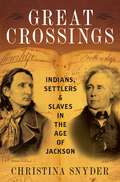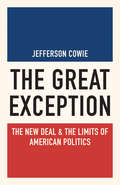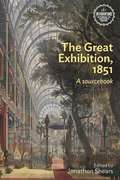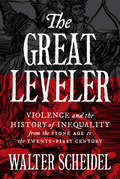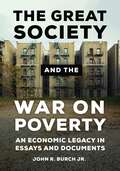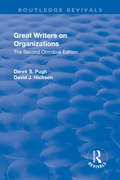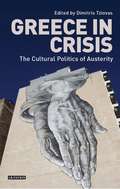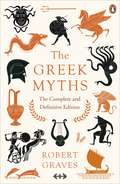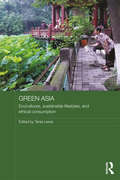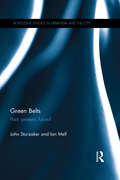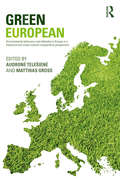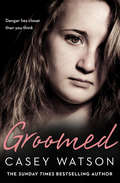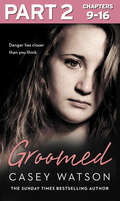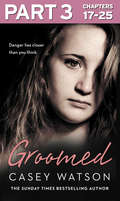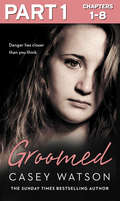- Table View
- List View
Great Crossings: Indians, Settlers, and Slaves in the Age of Jackson
by Christina SnyderIn Great Crossings: Indians, Settlers, and Slaves in the Age of Jackson, prize-winning historian Christina Snyder reinterprets the history of Jacksonian America. Most often, this drama focuses on whites who turned west to conquer a continent, extending "liberty" as they went. Great Crossings also includes Native Americans from across the continent seeking new ways to assert anciently-held rights and people of African descent who challenged the United States to live up to its ideals. These diverse groups met in an experimental community in central Kentucky called Great Crossings, home to the first federal Indian school and a famous interracial family. Great Crossings embodied monumental changes then transforming North America. The United States, within the span of a few decades, grew from an East Coast nation to a continental empire. The territorial growth of the United States forged a multicultural, multiracial society, but that diversity also sparked fierce debates over race, citizenship, and America's destiny. Great Crossings, a place of race-mixing and cultural exchange, emerged as a battleground. Its history provides an intimate view of the ambitions and struggles of Indians, settlers, and slaves who were trying to secure their place in a changing world. Through deep research and compelling prose, Snyder introduces us to a diverse range of historical actors: Richard Mentor Johnson, the politician who reportedly killed Tecumseh and then became schoolmaster to the sons of his former foes; Julia Chinn, Johnson's enslaved concubine, who fought for her children's freedom; and Peter Pitchlynn, a Choctaw intellectual who, even in the darkest days of Indian removal, argued for the future of Indian nations. Together, their stories demonstrate how this era transformed colonizers and the colonized alike, sowing the seeds of modern America.
The Great Exception: The New Deal and the Limits of American Politics
by Jefferson CowieWhere does the New Deal fit in the big picture of American history? What does it mean for us today? What happened to the economic equality it once engendered? In The Great Exception, Jefferson Cowie provides new answers to these important questions. In the period between the Great Depression and the 1970s, he argues, the United States government achieved a unique level of equality, using its considerable resources on behalf of working Americans in ways that it had not before and has not since. If there is to be a comparable battle for collective economic rights today, Cowie argues, it needs to build on an understanding of the unique political foundation for the New Deal. Anyone who wants to come to terms with the politics of inequality in the United States will need to read The Great Exception.
The Great Exhibition, 1851: A sourcebook (Interventions: Rethinking the Nineteenth Century,inventions rethinking nineteenth century)
by Jonathon ShearsAn invaluable compendium of sources relating to the Great Exhibition
The Great Exhibition, 1851: A sourcebook (Interventions: Rethinking the Nineteenth Century)
by Jonathon ShearsThe Great Exhibition, 1851: A Sourcebook is the first anthology of its kind. It presents a comprehensive array of carefully selected primary documents, sourced from the period before, during and after the Exhibition in Hyde Park in 1851. Drawing on contemporary newspapers and periodicals, the archives of the Royal Commission, diaries, journals, celebratory poems and essays, many of these documents are reproduced in their entirety, and in the same place, for the first time. The book provides an unparalleled resource for teachers and students of the Exhibition and a starting point for researchers new to the subject. Subdivided into six chapters - Origins and organisation, Display, Nation, empire and ethnicity, Gender, Class and Afterlives - it represents the current scholarly debates about the Exhibition, orientating readers with helpful, critically informed, introductions. What was the Great Exhibition and what did it mean? Readers of The Great Exhibition, 1851: A Sourcebook will take great pleasure in finding out.
The Great Leveler: Violence and the History of Inequality from the Stone Age to the Twenty-First Century
by Walter ScheidelHow only violence and catastrophes have consistently reduced inequality throughout world historyAre mass violence and catastrophes the only forces that can seriously decrease economic inequality? To judge by thousands of years of history, the answer is yes. Tracing the global history of inequality from the Stone Age to today, Walter Scheidel shows that inequality never dies peacefully. Inequality declines when carnage and disaster strike and increases when peace and stability return. The Great Leveler is the first book to chart the crucial role of violent shocks in reducing inequality over the full sweep of human history around the world. Ever since humans began to farm, herd livestock, and pass on their assets to future generations, economic inequality has been a defining feature of civilization. Over thousands of years, only violent events have significantly lessened inequality. The "Four Horsemen" of leveling—mass-mobilization warfare, transformative revolutions, state collapse, and catastrophic plagues—have repeatedly destroyed the fortunes of the rich. Scheidel identifies and examines these processes, from the crises of the earliest civilizations to the cataclysmic world wars and communist revolutions of the twentieth century. Today, the violence that reduced inequality in the past seems to have diminished, and that is a good thing. But it casts serious doubt on the prospects for a more equal future. An essential contribution to the debate about inequality, The Great Leveler provides important new insights about why inequality is so persistent—and why it is unlikely to decline anytime soon.
The Great Leveler: Violence and the History of Inequality from the Stone Age to the Twenty-First Century
by Walter ScheidelHow only violence and catastrophes have consistently reduced inequality throughout world historyAre mass violence and catastrophes the only forces that can seriously decrease economic inequality? To judge by thousands of years of history, the answer is yes. Tracing the global history of inequality from the Stone Age to today, Walter Scheidel shows that inequality never dies peacefully. Inequality declines when carnage and disaster strike and increases when peace and stability return. The Great Leveler is the first book to chart the crucial role of violent shocks in reducing inequality over the full sweep of human history around the world. Ever since humans began to farm, herd livestock, and pass on their assets to future generations, economic inequality has been a defining feature of civilization. Over thousands of years, only violent events have significantly lessened inequality. The "Four Horsemen" of leveling—mass-mobilization warfare, transformative revolutions, state collapse, and catastrophic plagues—have repeatedly destroyed the fortunes of the rich. Scheidel identifies and examines these processes, from the crises of the earliest civilizations to the cataclysmic world wars and communist revolutions of the twentieth century. Today, the violence that reduced inequality in the past seems to have diminished, and that is a good thing. But it casts serious doubt on the prospects for a more equal future. An essential contribution to the debate about inequality, The Great Leveler provides important new insights about why inequality is so persistent—and why it is unlikely to decline anytime soon.
The Great Society and the War on Poverty: An Economic Legacy in Essays and Documents
by John R. Jr.An ideal resource for students as well as general readers, this book comprehensively examines the Great Society era and identifies the effects of its legacy to the present day.With the assassination of President John F. Kennedy, Lyndon B. Johnson inherited from the Kennedy administration many of the pieces of what became the War on Poverty. In stark contrast to today, Johnson was aided by a U.S. Congress that was among the most productive in the history of the United States. Despite the accomplishments of the Great Society programs, they failed to accomplish their ultimate goal of eradicating poverty. Consequently, some 50 years after the Great Society and the War on Poverty, many of the issues that Johnson's administration and Congress dealt with then are in front of legislators today, such as an increase in the minimum wage and the growing divide between the wealthy and the poor.This reference book provides a historical perspective on the issues of today by looking to the Great Society period; identifies how the War on Poverty continues to impact the United States, both positively and negatively; and examines how the Nixon and Reagan administrations served to dismantle Johnson's achievements. This single-volume work also presents primary documents that enable readers to examine key historical sources directly. Included among these documents are The Council of Economic Advisers Economic Report of 1964; the Civil Rights Act of 1964; John F. Kennedy's Remarks Upon Signing the Economic Opportunity Act; The Negro Family: The Case for National Action (a.k.a. the Moynihan Report); and the Report of the National Advisory Commission on Civil Disorders (a.k.a. the Kerner Report).
The Great Society and the War on Poverty: An Economic Legacy in Essays and Documents
by John R. Jr.An ideal resource for students as well as general readers, this book comprehensively examines the Great Society era and identifies the effects of its legacy to the present day.With the assassination of President John F. Kennedy, Lyndon B. Johnson inherited from the Kennedy administration many of the pieces of what became the War on Poverty. In stark contrast to today, Johnson was aided by a U.S. Congress that was among the most productive in the history of the United States. Despite the accomplishments of the Great Society programs, they failed to accomplish their ultimate goal of eradicating poverty. Consequently, some 50 years after the Great Society and the War on Poverty, many of the issues that Johnson's administration and Congress dealt with then are in front of legislators today, such as an increase in the minimum wage and the growing divide between the wealthy and the poor.This reference book provides a historical perspective on the issues of today by looking to the Great Society period; identifies how the War on Poverty continues to impact the United States, both positively and negatively; and examines how the Nixon and Reagan administrations served to dismantle Johnson's achievements. This single-volume work also presents primary documents that enable readers to examine key historical sources directly. Included among these documents are The Council of Economic Advisers Economic Report of 1964; the Civil Rights Act of 1964; John F. Kennedy's Remarks Upon Signing the Economic Opportunity Act; The Negro Family: The Case for National Action (a.k.a. the Moynihan Report); and the Report of the National Advisory Commission on Civil Disorders (a.k.a. the Kerner Report).
Great Writers on Organizations: The Second Omnibus Edition
by Derek S Pugh David J HicksonThis title was first published in 2000: A collection of the thoughts of many great writers on organizations. These writers are from a variety of different backgrounds. Some draw upon their expertise as practising managers, some on their knowledge of rational and local government administration, and some on the findings of their research work. All have attempted to draw together information and distil theories about how organizations function and how they should be managed. The volume seeks to provide a general overview of the field, and does not provide critical analysis of the views provided.
Great Writers on Organizations: The Second Omnibus Edition
by Derek S Pugh David J HicksonThis title was first published in 2000: A collection of the thoughts of many great writers on organizations. These writers are from a variety of different backgrounds. Some draw upon their expertise as practising managers, some on their knowledge of rational and local government administration, and some on the findings of their research work. All have attempted to draw together information and distil theories about how organizations function and how they should be managed. The volume seeks to provide a general overview of the field, and does not provide critical analysis of the views provided.
Greece in Crisis: The Cultural Politics of Austerity (International Library of Historical Studies)
by CGP BooksSince 2010 Greece has been experiencing the longest period of austerity and economic downturn in its recent history. Economic changes may be happening more rapidly and be more visible than the cultural effects of the crisis which are likely to take longer to become visible, however in recent times, both at home and abroad, the Greek arts scene has been discussed mainly in terms of the crisis. While there is no shortage of accounts of Greece's economic crisis by financial and political analysts, the cultural impact of austerity has yet to be properly addressed. This book analyses hitherto uncharted cultural aspects of the Greek economic crisis by exploring the connections between austerity and culture. Covering literary, artistic and visual representations of the crisis, it includes a range of chapters focusing on different aspects of the cultural politics of austerity such as the uses of history and archaeology, the brain drain and the Greek diaspora, Greek cinema, museums, music festivals, street art and literature as well as manifestations of how the crisis has led Greeks to rethink or question cultural discourses and conceptions of identity.
The Greek Myths: The Complete and Definitive Edition
by Robert Graves*The definitive and comprehensive edition of Robert Graves's classic retelling of the Greek myths*'Icarus disobeyed his father's instructions and began soaring towards the sun, rejoiced by the lift of his great sweeping wings. Presently, when Daedalus looked over his shoulder, he could no longer see Icarus; but scattered feathers floated on the waves below...'These are the greatest stories ever told - the labours of Hercules, the voyage of the Argonauts, Theseus and the minotaur, Midas and his golden touch, the Trojan War and Odysseus's journey home - brought together into one epic and unforgettable story. Ideal for the first time reader, it can be read as a single page-turning narrative, while full commentaries as well as a comprehensive index of names make it equally valuable for anyone seeking an authoritative and detailed account of the spectacular stories that make up the bedrock of Western literature.The Greek Myths is a classic among classics, a treasure trove of extraordinary tales and a masterful work of literature in its own right.
Green Asia: Ecocultures, Sustainable Lifestyles, and Ethical Consumption (Media, Culture and Social Change in Asia)
by Tania LewisEconomic development in Asia is associated with expanding urbanism, overconsumption, and a steep growth in living standards. At the same time, rapid urbanisation, changing class consciousness, and a new rural–urban divide in the region have led to fundamental shifts in the way ecological concerns are articulated politically and culturally. Moreover, these changes are often viewed through a Western moralistic lens, which at the same time applauds Asia’s economic growth as the welcome reviver of a floundering world economy and simultaneously condemns this growth as encouraging hyperconsumerism and a rupture with more natural ways of living. This book presents an analysis of a range of practices and activities from across Asia that demonstrate that people in Asia are alert to ecological concerns, that they are taking action to implement new styles of green living, and that Asia offers interesting alternatives to narrow Anglo-American models of sustainable living. Subjects explored include eco-tourism in the Philippines, green co-operatives in Korea, the importance of "tradition" within Asian discourses of sustainability, and much more.
Green Asia: Ecocultures, Sustainable Lifestyles, and Ethical Consumption (Media, Culture and Social Change in Asia)
by Tania LewisEconomic development in Asia is associated with expanding urbanism, overconsumption, and a steep growth in living standards. At the same time, rapid urbanisation, changing class consciousness, and a new rural–urban divide in the region have led to fundamental shifts in the way ecological concerns are articulated politically and culturally. Moreover, these changes are often viewed through a Western moralistic lens, which at the same time applauds Asia’s economic growth as the welcome reviver of a floundering world economy and simultaneously condemns this growth as encouraging hyperconsumerism and a rupture with more natural ways of living. This book presents an analysis of a range of practices and activities from across Asia that demonstrate that people in Asia are alert to ecological concerns, that they are taking action to implement new styles of green living, and that Asia offers interesting alternatives to narrow Anglo-American models of sustainable living. Subjects explored include eco-tourism in the Philippines, green co-operatives in Korea, the importance of "tradition" within Asian discourses of sustainability, and much more.
Green Belts: Past; present; future? (Routledge Studies in Urbanism and the City)
by Ian Mell John SturzakerMost of us have heard of green belts – but how much do we really know about them? This book tries to separate the fact from the fiction when it comes to green belts by looking both backwards and forwards. They were introduced in the mid-twentieth century to try and stop cities merging together as they grew. There is little doubt they have been very effective at doing that, but at what cost? Are green belts still the answer to today’s problems of an increasing population and ever higher demands on our natural resources? Green Belts: Past; present; future? reflects upon green belts in the United Kingdom at a time when they have perhaps never been more valued by the public or under more pressure from development. The book begins with a historical study of the development of green belt ideas, policy and practice from the nineteenth century to the present. It discusses the impacts and characteristics of green belts and attempts to reconcile perceptions and reality. By observing examples of green belts and similar policies in other parts of the world, the authors ask what we want green belts to achieve and suggest alternative ways in which that could be done, before looking forward to consider how things might change in the coming years. This book draws together information from a range of sources to present, for the first time, a comprehensive study of green belts in the UK. It reflects upon the gap between perception and reality about green belts, analyses their impacts on rural and urban areas, and questions why they retain such popular support and whether they are still the right solution for the UK and elsewhere. It will be of interest to anyone who is concerned with planning and development and how we can provide the homes, jobs and services we need while protecting our more valuable natural assets.
Green Belts: Past; present; future? (Routledge Studies in Urbanism and the City)
by Ian Mell John SturzakerMost of us have heard of green belts – but how much do we really know about them? This book tries to separate the fact from the fiction when it comes to green belts by looking both backwards and forwards. They were introduced in the mid-twentieth century to try and stop cities merging together as they grew. There is little doubt they have been very effective at doing that, but at what cost? Are green belts still the answer to today’s problems of an increasing population and ever higher demands on our natural resources? Green Belts: Past; present; future? reflects upon green belts in the United Kingdom at a time when they have perhaps never been more valued by the public or under more pressure from development. The book begins with a historical study of the development of green belt ideas, policy and practice from the nineteenth century to the present. It discusses the impacts and characteristics of green belts and attempts to reconcile perceptions and reality. By observing examples of green belts and similar policies in other parts of the world, the authors ask what we want green belts to achieve and suggest alternative ways in which that could be done, before looking forward to consider how things might change in the coming years. This book draws together information from a range of sources to present, for the first time, a comprehensive study of green belts in the UK. It reflects upon the gap between perception and reality about green belts, analyses their impacts on rural and urban areas, and questions why they retain such popular support and whether they are still the right solution for the UK and elsewhere. It will be of interest to anyone who is concerned with planning and development and how we can provide the homes, jobs and services we need while protecting our more valuable natural assets.
Green European: Environmental Behaviour and Attitudes in Europe in a Historical and Cross-Cultural Comparative Perspective (Studies in European Sociology)
by Audrone Telesiene Matthias GrossGreen European addresses the quest for a better understanding of European type(s) of environmentalism. This monograph focuses on public attitudes and behaviours and the culturally rooted as well as country specific differences. The book addresses the wider issue that many European countries are rendered ‘green’ or as having an advanced environmental awareness, but the question - ‘how green are Green Europeans really’, is yet to be answered. The book covers a variety of unique data-driven comparative studies and is divided into three parts: the first addresses perceptions of environmental and technological threats and risks, the second part deals with environmental activism in Europe, the third discusses environmental attitudes, environmental concerns and their imminent link to personal pro-environmental behaviour. The empirical comparative nature of the contributions is enabled by data from the International Social Survey Programme (ISSP).
Green European: Environmental Behaviour and Attitudes in Europe in a Historical and Cross-Cultural Comparative Perspective (Studies in European Sociology)
by Matthias Gross Audronė TelešienėGreen European addresses the quest for a better understanding of European type(s) of environmentalism. This monograph focuses on public attitudes and behaviours and the culturally rooted as well as country specific differences. The book addresses the wider issue that many European countries are rendered ‘green’ or as having an advanced environmental awareness, but the question - ‘how green are Green Europeans really’, is yet to be answered. The book covers a variety of unique data-driven comparative studies and is divided into three parts: the first addresses perceptions of environmental and technological threats and risks, the second part deals with environmental activism in Europe, the third discusses environmental attitudes, environmental concerns and their imminent link to personal pro-environmental behaviour. The empirical comparative nature of the contributions is enabled by data from the International Social Survey Programme (ISSP).
Grenzobjekte und Medienforschung: (hg. von Sebastian Gießmann und Nadine Taha) (Locating Media/Situierte Medien #10)
by Susan Leigh Star (verst.)Susan Leigh Stars (1954-2010) Werk bewegt sich zwischen Infrastrukturforschung, Sozialtheorie, Wissenschaftsgeschichte, Ökologie und Feminismus. Die wegweisenden historischen und ethnografischen Texte der US-amerikanischen Technik- und Wissenschaftssoziologin liegen mit diesem Band erstmals gesammelt auf Deutsch vor. Ihre Arbeiten zu Grenzobjekten, Marginalität, Arbeit, Infrastrukturen und Praxisgemeinschaften werden interdisziplinär kommentiert und auf ihre medienwissenschaftliche Produktivität hin befragt. Mit Kommentaren von Geoffrey C. Bowker, Cora Bender, Ulrike Bergermann, Monika Dommann, Christine Hanke, Bernhard Nett, Jörg Potthast, Gabriele Schabacher, Cornelius Schubert, Erhard Schüttpelz und Jörg Strübing.
Grenzobjekte und Medienforschung: (hg. von Sebastian Gießmann und Nadine Taha) (Locating Media/Situierte Medien #10)
by Susan Leigh Star (verst.)Susan Leigh Stars (1954-2010) Werk bewegt sich zwischen Infrastrukturforschung, Sozialtheorie, Wissenschaftsgeschichte, Ökologie und Feminismus. Die wegweisenden historischen und ethnografischen Texte der US-amerikanischen Technik- und Wissenschaftssoziologin liegen mit diesem Band erstmals gesammelt auf Deutsch vor. Ihre Arbeiten zu Grenzobjekten, Marginalität, Arbeit, Infrastrukturen und Praxisgemeinschaften werden interdisziplinär kommentiert und auf ihre medienwissenschaftliche Produktivität hin befragt. Mit Kommentaren von Geoffrey C. Bowker, Cora Bender, Ulrike Bergermann, Monika Dommann, Christine Hanke, Bernhard Nett, Jörg Potthast, Gabriele Schabacher, Cornelius Schubert, Erhard Schüttpelz und Jörg Strübing.
Grenzüberschreitend forschen: Kulturwissenschaftliche Perspektiven auf Trans*Syndrome (Edition Kulturwissenschaft #123)
by Béatrice Hendrich Sandra Kurfürst Anna MalisWas verbirgt sich hinter der oft verwendeten Vorsilbe Trans*? Um diese Frage aus kultur- und sozialwissenschaftlicher Perspektive zu beleuchten, stellen die Beiträge des Bandes aktuelle grenzüberschreitende Praktiken, Konzepte und Austauschbeziehungen vor. Sie zeigen: Gerade für die hier betrachteten Regionen - vom Nahen Osten und Indien über Süd- bis nach Ostasien - haben Trans*Syndrome eine wichtige Bedeutung. Die kulturelle und wirtschaftliche Auseinandersetzung mit dem Rest der Welt führt zu Konflikten in Alltag, Kultur und Politik. Es kommt aber auch zu Prozessen der Übersetzung, Grenzüberschreitung und Verwandlung, was neue Perspektiven und Praktiken hervorbringt.
Groomed: A Troubled Girl. A Shocking Allegation. Is It Too Late To Uncover The Truth?
by Casey WatsonIt’s late on Friday night when Casey’s mobile starts to ring. She is expecting it to be her daughter Riley. But it isn’t Riley. It’s a woman from the Emergency Duty Team. So begins Casey and Mike’s latest fostering challenge – a fifteen-year-old girl called Keeley who’s run away from her long-term foster home 25 miles away.
Groomed: A Troubled Girl. A Shocking Allegation. Is It Too Late To Uncover The Truth?
by Casey WatsonIt’s late on Friday night when Casey’s mobile starts to ring. She is expecting it to be her daughter Riley. But it isn’t Riley. It’s a woman from the Emergency Duty Team. So begins Casey and Mike’s latest fostering challenge – a fifteen-year-old girl called Keeley who’s run away from her long-term foster home 25 miles away.
Groomed: A Troubled Girl. A Shocking Allegation. Is It Too Late To Uncover The Truth?
by Casey WatsonIt’s late on Friday night when Casey’s mobile starts to ring. She is expecting it to be her daughter Riley. But it isn’t Riley. It’s a woman from the Emergency Duty Team. So begins Casey and Mike’s latest fostering challenge – a fifteen-year-old girl called Keeley who’s run away from her long-term foster home 25 miles away.
Groomed: Part 1 of 3: Danger lies closer than you think
by Casey WatsonIt’s late on Friday night when Casey’s mobile starts to ring. She is expecting it to be her daughter Riley. But it isn’t Riley. It’s a woman from the Emergency Duty Team. So begins Casey and Mike’s latest fostering challenge – a fifteen-year-old girl called Keeley who’s run away from her long-term foster home 25 miles away.
